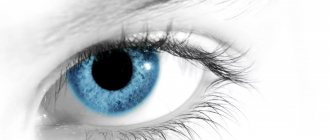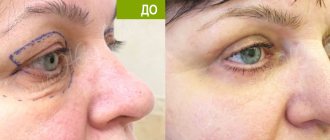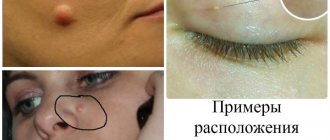Blepharoplasty is a surgical (plastic) operation that helps get rid of excess skin and fat in the upper and lower eyelids. As a result, the face (skin around the eyes) takes on a more toned and fresh appearance. However, this is not only a cosmetic procedure: such an intervention can solve defects that worsen a person’s quality of life. The medical indication for blepharoplasty is eyelid ptosis. There are several types of such operations: upper blepharoplasty, lower blepharoplasty, transconjunctival blepharoplasty. They differ from each other in the area of influence. After the consultation, the specialist will tell you which blepharoplasty is suitable in your case.
Types of blepharoplasty
Blepharoplasty is a whole complex of surgical operations performed on the eyelids. Each type of intervention is aimed at eliminating a specific defect. The following types of blepharoplasty are distinguished:
- Upper. The most common type of operation. Involves removal of skin and excess fat in the upper eyelid area. As a result, the skin stretches and the look becomes fresh.
- Bottom. The surgery removes excess skin and fat from the lower eyelids.
- Circular. This type of surgery is aimed at lifting both the upper and lower eyelids at the same time. As a result, you can achieve an excellent anti-aging effect.
- Transconjunctival. This is a gentle type of operation in which all manipulations are performed through an incision on the conjunctival surface of the eyelid. As a result, the rehabilitation period is reduced to 1 week, and pain is practically absent.
- Canthoplasty. A special technique aimed at not changing the shape and shape of the eyes;
- Europeanization, or plastic surgery of Asian eyelids. A type of blepharoplasty in which the surgeon shapes the fold of the upper eyelid and, if necessary, removes the epicanthus. As a result, the distance between the eyes visually decreases, the gaze becomes open.
- Canthopexy. An operation designed to lift the corners of the eyes. As a result, the face looks fresher and more youthful.
Complications
The disease is not life-threatening. In most cases, the consequences are psychological in nature, provoking the emergence of complexes, the development of shyness, internal constriction from the awareness of a defect in appearance. A narrowing of the visual field and headaches also begin.
It is more difficult for children; progression of amblyopia and other disorders, including binocular vision, is possible. The outlines of objects are distorted, which causes partial disorientation in space. In severe forms, there is a high probability of developing a myasthenic crisis.
If the causes of facial ptosis and drooping upper eyelid are found, the doctor will tell you what to do, how to fight and remove the main symptoms. This will not be difficult, since the actions will be targeted, and the methods will be clearly selected and comprehensive.
How is eyelid lift surgery performed?
There are several types of blepharoplasty, each of them differs in technique and results. The doctor will choose the method of intervention after a personal examination.
Upper eyelid blepharoplasty
Upper eyelid blepharoplasty is performed at any age. The operation helps to get rid of fatty hernias above the eyes or severe ptosis. The intervention is performed under general or local anesthesia, the procedure lasts about an hour. Before surgery, the doctor makes markings: determines the places where there is excess skin.
Next, following the markings, a skin incision is made, fatty hernias are isolated and removed, which are removed along with excess skin. Then the doctor applies a cosmetic suture, which is removed after 7-10 days. As a result, a thin scar remains, which completely heals in 1-2 months and becomes almost invisible.
Lower eyelid blepharoplasty
Blepharoplasty of the lower eyelids helps not only with facial wrinkles. This operation also effectively copes with sagging musculocutaneous tissue, fatty hernias, skin folds, and bags under the eyes.
The average duration of lower eyelid blepharoplasty is 40-60 minutes. The essence of the intervention is to correct the lower eyelid area: the doctor cuts the skin 2 mm from the eyelash growth line. Then he identifies fatty hernias and excises them along with excess skin. Afterwards, cosmetic stitches and a blindfold are applied.
The consequences of lower eyelid blepharoplasty can only be assessed after 1-2 months: you need to wait until the swelling has completely subsided and the stitches have dissolved. This rejuvenation technique is considered highly effective; the results last for 7-10 years.
Circular eyelid surgery
Circular blepharoplasty is the most effective plastic surgery that can cope with sagging, fatty hernias and facial wrinkles. Thanks to this procedure, it is possible to tighten the skin of both the upper and lower eyelids, remove age-related changes or congenital defects.
Circular blepharoplasty is a complex surgical procedure, which is why it requires special training and experience from the surgeon. The duration of the operation is 1.5-3 hours: it all depends on the chosen technique. The essence of circular blepharoplasty is to combine lifting of the upper and lower eyelids.
Correction of the corners of the eyes
Correction of the corners of the eyes is canthopexy. Usually performed in conjunction with lower blepharoplasty. The operation is performed to restore the face to a youthful and fresh appearance. The intervention is carried out under local (superficial sleep) or general anesthesia. The doctor makes an incision in the natural crease of the outer surface of the eyelid, through which he reaches the canthal tendon. This is what holds the corners of the lower eyelid. The tendon is stretched and fixed at the periosteum of the orbit. Then it is fixed with a cosmetic suture.
If there is too much skin in the lower eyelid area, fragments of it are removed. In this case, the muscles are not excised: they are stretched and fixed together with the tendon at the periosteum. The operation ends with excision of excess skin and suturing. As a result, there will be 2 nodules on the surface: at the beginning and end of the cut. After 5 days, the stitches are removed, they heal quickly, turn pale and become invisible.
Causes of ptosis of the upper eyelid
The term comes from a Greek word and means “overhanging or falling.”
The low location of the movable skin fold reduces the field of vision or completely disrupts it on the altered side. In this case, the anomaly can be congenital or acquired. It is considered normal if the cornea is covered by approximately 0.5-2 mm. If a muscle is atrophied or weakened, pathology occurs. Correct diagnosis allows the doctor to choose an adequate control strategy using therapeutic or surgical methods. The most common are:
- weakening of muscles;
- age-related gravitational changes;
- nerve ending paralysis;
- endocrine and other diseases;
- disruptions in the nervous system.
Among the reasons are diabetes mellitus and incorrect Botox injections.
Contraindications
Blepharoplasty is an operation that can solve serious aesthetic problems. However, it is not performed if there are the following contraindications:
- Inflammatory and other pathological processes around the eyes;
- Oncological neoplasms in the body;
- Diabetes;
- Systemic blood diseases;
- Pregnancy, breastfeeding period;
- Irritable eye syndrome;
- Increased intracranial and intraocular pressure;
- Persistent arterial hypertension.
Features of congenital pathology
In this case, part of the visual field is blocked, which causes dangerous complications to develop. In children of preschool and primary school age, a similar problem leads to delayed mental development, as well as the formation of complexes. There is a very high probability of progression of amblyopia, heterotopia, astigmatism, and binocular vision impairment.
Depending on the severity of the pathology and the individual characteristics of the patient’s body, a treatment regimen using conservative therapy is developed. If there is no result or the changes are too large, doctors prescribe surgery. Correction is a necessity, otherwise the omission leads to distortion of visual images in the child’s brain. The congenital form in the vast majority of cases will be transmitted from parents; a direct connection with a chromosomal malfunction is possible. Myasthenic ptosis is considered a variety, which is more visible externally in the evening; a characteristic symptom is quickly occurring fatigue of the facial muscles, especially in the area around the eyes.
Autoimmune diseases, intrauterine disorders of fetal formation, and tumors increase the risk of developing the disease. Congenital ptosis is also diagnosed in Duane and Horner syndromes; concomitant symptoms are narrowing of the palpebral fissures, deficiency of tear fluid, and deterioration in the quality of twilight vision.
How is rehabilitation going?
On average, the rehabilitation period after blepharoplasty takes 2-3 weeks. Immediately after surgery, the patient may feel discomfort, increased sensitivity to light, and pain. 7-14 days after surgery, the doctor removes the stitches and applies a patch, which helps reduce swelling. You need to wear it for 7-10 days. During this period, it is recommended to sleep on your back.
For home care, the doctor prescribes antiseptic drugs to treat the wound. Swelling and hematoma may increase, but you should not be afraid of this; these symptoms will soon disappear. 4 weeks after blepharoplasty, traces of surgical intervention completely disappear. You need to follow the doctor's recommendations for another 2 months. Don't forget the following rules:
- Take prescribed medications;
- Treat eyelids;
- Avoid physical activity;
- Avoid unnecessary touching of eyes;
- On applying makeup;
- Avoid alcohol and smoking;
- Don't strain your eyes.
After blepharoplasty, it is recommended to constantly use creams with an SPF factor. This will help your skin stay healthy and youthful longer. For 4 weeks you will have to give up visiting the bathhouse, sauna, swimming pool, and intense physical activity. Protect your eyes from possible injury. After a few months, the body will fully recover, the scars will heal - and it will be possible to evaluate the final result of the operation.
Diagnostics
It is worth considering that the most effective measures can be taken in the early stages of diseases. Unfortunately, at this stage it is very difficult to notice changes. You should be wary:
- visual enlargement of the skin fold;
- eyelid asymmetry;
- narrowing of the field of view;
- rapid fatigue of facial muscles;
- the desire to tilt your head back to examine a small detail in detail;
- the appearance of longitudinal wrinkles on the forehead.
If you suspect the development of pathology, you should contact a specialist to clarify the diagnosis. First of all, it is determined whether the anomaly is congenital or acquired. Next, an examination is carried out to determine the degree of prolapse. In case of vision problems, it is necessary to evaluate how much the field has narrowed, measure the eye pressure and examine the condition of the fundus. The next step is to check muscle tone and blinking function, and the quality of binocular vision.
Among the examinations that are prescribed:
- X-ray;
- MRI;
- Ultrasound;
- electromyography.
In some cases, with an unclear etiology, consultation with a neurosurgeon, endocrinologist, or neurologist may be necessary. The disease develops gradually.
1st degree
The upper eyelid hangs over the cornea or covers a third of the pupil. At this stage, there are quite a few options for how to treat eye ptosis. Basically, they are of a conservative direction, since there is no serious threat to visual acuity, the main concern is the cosmetic effect.
2nd degree
At this stage, half to two-thirds of the pupil closes, pain, headache, and overstrain of the muscles of the face and neck appear. Visually, the violation is clearly visible and causes not only psychological, but also physiological discomfort.
3rd degree
At this stage the pupil is completely closed. Surgery and long-term rehabilitation, including several stages, are required. The first step is to identify the causes, both the main ones and the accompanying ones. Only then can treatment be prescribed, constantly monitoring the patient’s well-being and the process of restoration of visual functions.
We recommend
GHC Placental Cosmetic - 3-D modeling mask with placenta hydrolyzate
Bb Laboratories – Regenerating placental-hyaluronic mask
Bb Laboratories – Anti-aging lifting cream
Bb Laboratories – Lifting patches
Stories from our patients:
Elena24.12.2021
I want to thank the wonderful surgeon Tatyana Aleksandrovna Ivanchenkova for my new body! Simply delighted with the changed proportions, new me! The operation took place on November 11, 2021, lasted 5 hours, a large volume including mini-abdomino, legs, arms, back, sides, lipofilling, and in addition, repeated mammoplasty of the breast, which was performed by Tatyana Alexandrovna’s colleague, the highly respected Valery Grigorievich Yakimets. I liked Tatyana Aleksandrovna from the first consultation: confident, calm, her vision of the desired result coincided 100% with mine, so I didn’t even consider other surgeons. The clinic has a well-coordinated team, a real team, I especially want to thank the administrator and main organizer of the processes, Alexandra, who resolved all my questions as quickly and competently as possible. The operation itself took place in one of the best clinics in Moscow at the moment, K+31. This is a well-equipped hospital complex with attentive medical staff. Postoperative rehabilitation went quickly, under the strict control and examinations of Tatyana Alexandrovna. I liked her sense of humor, which was always appropriate and supportive. Tatyana Aleksandrovna is an “old school” surgeon, very experienced, so I didn’t feel fear or anxiety, there was trust, which justified itself. 20-year-old girls (I'm 42!) can envy such a waist, belly and hips. I wish every woman to experience the same emotions after the Transfiguration in the hands of Tatyana Alexandrovna Ivanchenkova!
Read moreHide
Irina Shevchenko05/03/2021
To the best plastic surgeon in Russia!!!!!!!!!!!!!!!!!!!!!!!! I would like to express my deep gratitude to Valery Grigorievich for his professionalism and my beautiful face. She had surgery on September 31, 2020, at the height of Covid19 restrictions. The clinic complies with all the necessary requirements for conducting surgery during Covid19. The operation was VERY SUCCESSFUL. Coming out of anesthesia was easy and not noticeable. My face is getting better and better every day and every month. Also, many thanks to the entire Estet Clinic team, everyone is in their place and all great professionals. Highly recommend!!!!!!
Read moreHide
Yulia29.01.2021
Many thanks to the wonderful doctor Valery Grigorievich! I had rejuvenation surgery in 2016. Several years have passed, nothing has changed, only everything has gotten better! Especially the neck, you have no equal in this! There is no need to wait for quick rehabilitation and quick results! Everything will be great, but in a year... At least in my case, everything is individual! But, you are the best! I hope to meet you again, health permitting!
Read moreHide
What result should I expect?
It all depends on the nature of the problem. If you were unhappy with the presence of bags under your eyes, lower eyelid surgery will eliminate this defect completely. If the problem was deep folds or a pronounced tear trough, eyelid skin tightening can be combined with lipofilling - the relief will be leveled, the skin will become more elastic and dense.
Blepharoplasty with canthopexy will lift the outer edges of the eyes - the face will look more fresh and joyful (subconsciously drooping edges of the eyes are perceived as a sign of sadness).
Cost of lower blepharoplasty
RUB 51,000
Make an appointment









